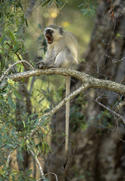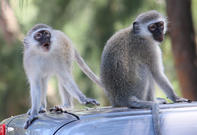Sentinel Duty

Because of their vested paternal interest in the troop, the more dominant males perform the service as sentinel most reliably and raise the alarm more frequently than the other members of the group.
At the alarm, the other vervets will look immediately to the sentinel to determine the direction of the threat. In the case of a bird of prey, the troop will take to the densest part of the tree canopy to hide. In the case of a snake, they may rise up on their hind legs and chatter agitatedly.
The sentinel also provides a passive alarm system by occupying a conspicuous perch while the troop forages.
His white belly is obvious to the members of the troop and the presence of the male on his perch assures the foragers that the coast is clear.
Should the sentinel abandon his post, the entire troop will notice and quietly slip into cover.
By not raising the alarm, the troop can escape the attention of predators that may not yet have noticed them. Vervets also respond to the alarm calls of birds.
Did You Call?

Vervet monkeys have an impressive vocal repertoire with 36 calls recorded but there is a probability more exist. At least six different alarm signals have been identified and are used to indicate the presence of different types of predators be it an aerial threat, i.e. bird of prey, or a prowling leopard.
When distressed, vervets will alarm call constantly and stare in the direction of the source of disturbance making it possible for humans to locate predators by following the gaze of the alarming animals. Play is an important mechanism of learning.
Young monkeys learn skills and hone the muscles they need to become independent of their parents and fend for themselves amongst a troop. Young animals learn how to integrate socially through play and mimic the older animals’ actions in the process of learning what to eat and which alarm signals denote which predators.
By Megan Emmett